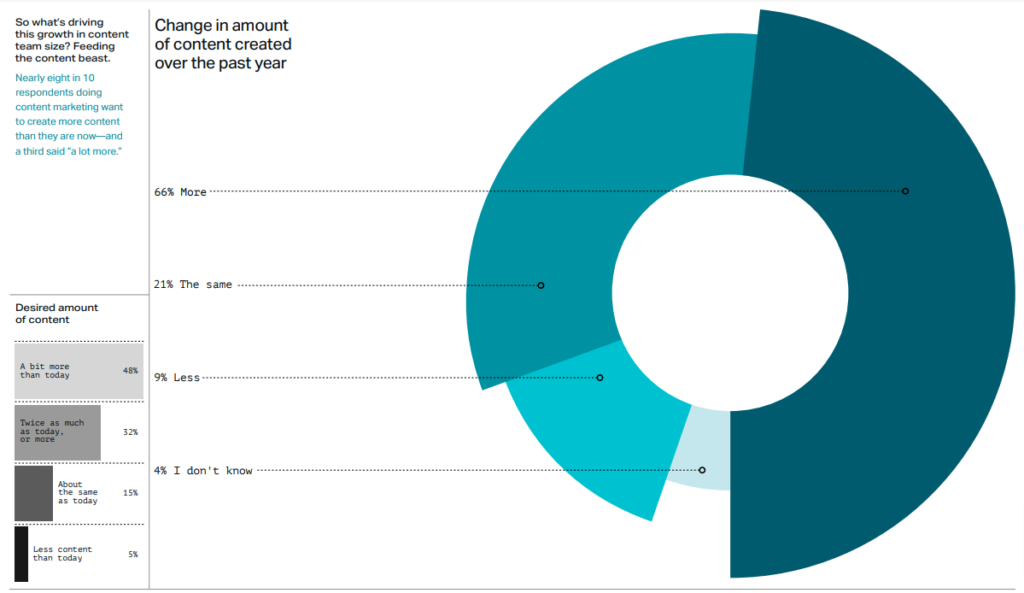|
Getting your Trinity Audio player ready...
|
66% of the respondents to a Parse.ly survey say that they have increased content creation over the past year and nearly 8 in 10 would like to create more content.
The cross-industry survey with over 800 participants (13.6% from publishing and media) explores the role of content and content marketing in today’s organizations.
The findings are presented in Parse.ly’s Content Matters 2022 report. It outlines how the participating companies are using content for growth, how much they’re spending on that content, what channels they want to pursue next, what technology they’re integrating with, and trends they see heading into 2022.
“Challenge for many content teams”
“Keeping up with the increasing desire for more content is a challenge for many content teams,” according to the report. A common challenge is the lack of people to produce content. Most companies in the survey have teams of 10 or less. However, more than half say they are now growing their content teams. 50% have increased their content budgets, while 30% have maintained theirs. Most of the budget is being spent on “more content creators, rather than technology to make content creation more efficient,” the authors write.
The spending gap between people and technology is striking and speaks to the relative maturity of content marketing in comparison to other marketing disciplines. Clearly, to be effective, organizations must balance people, process, and technology.
Content Matters 2022, Parse.ly
Content is used primarily to drive top-of-funnel activities
Most businesses use content primarily for driving top-of-funnel activities like brand awareness, education, and trust-building on owned channels. Popular bottom-of-funnel activities served by content include generating demand and business leads and generating sales and revenue.
Although companies distribute their content across many channels, owned channels are the top priority. The most popular options are blog posts, organic social media, and email newsletters. Many respondents say they use paid social media and search ads. However, the choice of channels varies depending on company type. For example, most B2B respondents prefer LinkedIn, while B2C tend to go for Facebook.
To drive top-of-funnel conversions, content is the fuel that energizes a wide variety of channels—an average of four to seven in play for most businesses we surveyed.
Content Matters 2022, Parse.ly

Coming to content type, most respondents would like to create more videos however they are deterred by the lack of resources. And although blog and social media content output is high across industries, most companies want to create more infographics and traditional in-depth content like white papers, reports, ebooks, and guides.
Video isn’t just for young, glam consumer brands today. Businesses of all sizes, across industries and segments, want to get in on the action—and no wonder, considering the higher audience engagement levels that come with video.
Content Matters 2022, Parse.ly
The authors expect video to play a “greater starring role in enterprise and B2B content marketing circles” in 2022 as mobiles and handheld devices close gaps in video quality and editing capabilities. “It wouldn’t surprise us to see content teams take a DIY, guerilla marketing approach to video shoots and production to promote assets, webinars, events, and more,” they write.
“Listen to whomever is screaming loudest”
Getting an accurate understanding of content performance is another area of challenge. Although more than three in four survey respondents say they use metrics to measure their content performance, almost half still do not have clarity about it.
Moreover, the most commonly used metrics—page views and email clicks—”offer little hard analysis of how content is performing, and don’t tell the full story of a customer’s lifecycle journey,” according to the authors.

This lack of accurate insight into content performance affects content strategy decisions. “Unfortunately, the answer seems to be “listen to whomever is screaming loudest,”” the authors write. 68.7% say that content marketing decisions are driven by other teams like sales, support, etc., followed by content analytics/intelligence (53.6%) and anecdotal evidence (51.6%).
“Clearly, legacy analytics tools haven’t caught up with the modern content marketing approaches companies now favor,” the authors conclude. “Because content is seen as a valuable tool for revenue growth, brand awareness, customer education, and building trust, those vanity metrics like page views and clicks simply don’t cut it in 2022.”
It’s time to move beyond content strategy decisions arrived at by holding a finger to the wind.
Content Matters 2022, Parse.ly
The full report can be downloaded from Parse.ly:
Content Matters 2022






